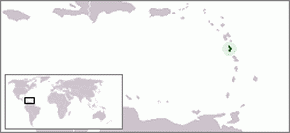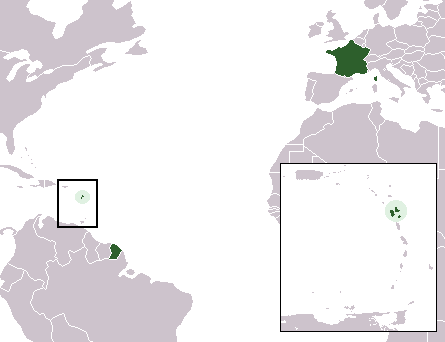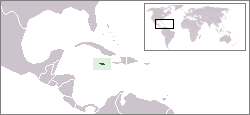|
Tamayoa Decolorata
''Tamayoa decolorata'' is a species of air-breathing land snail,a terrestrial pulmonate gastropod mollusk in the family Scolodontidae. Distribution The distribution of ''Tamayoa decolorata'' includes: * Jamaica * Guadeloupe * Dominica This species is probably an introduced one in Dominica, as it was found only in disturbed habitats. * Martinique(1 January 2009)"2008 Collecting Trip in Martinique". accessed 3 January 2011. * Barbados * Saint Vincent * Tobago * Trinidad * French Guiana * Brazil References This article incorporates CC-BY-3.0 text from the reference Robinson D. G., Hovestadt A., Fields A. & Breure A. S. H. (July 2009). "The land Mollusca of Dominica (Lesser Antilles), with notes on some enigmatic or rare species". ''Zoologische Mededelingen ''Zoologische Mededelingen'' was a peer-reviewed open access scientific journal publishing papers and monographs on animal systematics. The publisher was the National Museum of Natural History Naturalis in the Netherlands. T ... [...More Info...] [...Related Items...] OR: [Wikipedia] [Google] [Baidu] |
Animalia
Animals are multicellular, eukaryotic organisms in the biological kingdom Animalia. With few exceptions, animals consume organic material, breathe oxygen, are able to move, can reproduce sexually, and go through an ontogenetic stage in which their body consists of a hollow sphere of cells, the blastula, during embryonic development. Over 1.5 million living animal species have been described—of which around 1 million are insects—but it has been estimated there are over 7 million animal species in total. Animals range in length from to . They have complex interactions with each other and their environments, forming intricate food webs. The scientific study of animals is known as zoology. Most living animal species are in Bilateria, a clade whose members have a bilaterally symmetric body plan. The Bilateria include the protostomes, containing animals such as nematodes, arthropods, flatworms, annelids and molluscs, and the deuterostomes, containing the echinode ... [...More Info...] [...Related Items...] OR: [Wikipedia] [Google] [Baidu] |
Terrestrial Animal
Terrestrial animals are animals that live predominantly or entirely on land (e.g. cats, dogs, ants, spiders), as compared with aquatic animals, which live predominantly or entirely in the water (e.g. fish, lobsters, octopuses), and amphibians, which rely on a combination of aquatic and terrestrial habitats (e.g. frogs and newts). Some groups of insects are terrestrial, such as ants, butterflies, earwigs, cockroaches, grasshoppers and many others, while other groups are partially aquatic, such as mosquitoes and dragonflies, which pass their larval stages in water. Terrestrial animals tend to be more developed and intelligent than aquatic animals. Terrestrial classes The term "terrestrial" is typically applied to species that live primarily on the ground, in contrast to arboreal species, which live primarily in trees. There are other less common terms that apply to specific groups of terrestrial animals: *Saxicolous creatures are rock dwelling. "Saxicolous" is derived from t ... [...More Info...] [...Related Items...] OR: [Wikipedia] [Google] [Baidu] |
List Of Non-marine Molluscs Of Brazil
The non-marine molluscs of Brazil are a part of the molluscan fauna of Brazil. There are at least 1,074Simone, L. R. L. 2006. ''Land and Freshwater Molluscs of Brazil''. EGB, Fapesp. São Paulo, Brazil. 390 pp. .book review) native nominal species of non-marine molluscs living in Brazil. There are at least 956 nominal species of gastropods, which breaks down to about 250 species of freshwater gastropods, and about 700 species of land gastropods (590 species of snails and approximately 110(?) species of slugs), plus at least 117 species of bivalves living in the wild. There are at least 373 species of freshwater molluscs in Brazil. The number of native species is at least 1,074 and the number of non-indigenous molluscs in Brazil is, at minimum, 32 species. The most serious invasive alien species in Paraná State are the land snail ''Achatina fulica'' and the freshwater snail ''Melanoides tuberculata''. In Rio Grande do Sul, 201 species and subspecies of non-marine mollusks ... [...More Info...] [...Related Items...] OR: [Wikipedia] [Google] [Baidu] |
French Guiana
French Guiana ( or ; french: link=no, Guyane ; gcr, label=French Guianese Creole, Lagwiyann ) is an overseas departments and regions of France, overseas department/region and single territorial collectivity of France on the northern Atlantic Ocean, Atlantic coast of South America in the Guianas. It borders Brazil to the east and south and Suriname to the west. With a land area of , French Guiana is the second-largest Regions of France, region of France (more than one-seventh the size of Metropolitan France) and the largest Special member state territories and the European Union, outermost region within the European Union. It has a very low population density, with only . (Its population is less than that of Metropolitan France.) Half of its 294,436 inhabitants in 2022 lived in the metropolitan area of Cayenne, its Prefectures in France, capital. 98.9% of the land territory of French Guiana is covered by forests, a large part of which is Old-growth forest, primeval Tropical r ... [...More Info...] [...Related Items...] OR: [Wikipedia] [Google] [Baidu] |
Trinidad
Trinidad is the larger and more populous of the two major islands of Trinidad and Tobago. The island lies off the northeastern coast of Venezuela and sits on the continental shelf of South America. It is often referred to as the southernmost island in the West Indies. With an area of , it is also the List of Caribbean islands by area, fifth largest in the West Indies. Name The original name for the island in the Arawak language, Arawaks' language was which meant "Land of the Hummingbird". Christopher Columbus renamed it ('The Island of the Holy Trinity, Trinity'), fulfilling a vow he had made before setting out on his third voyage. This has since been shortened to ''Trinidad''. History Island Caribs, Caribs and Arawaks lived in Trinidad long before Christopher Columbus encountered the islands on his third voyage on 31 July 1498. The island remained Spanish until 1797, but it was largely settled by French colonists from the French Caribbean, especially Martinique.Besson, ... [...More Info...] [...Related Items...] OR: [Wikipedia] [Google] [Baidu] |
Tobago
Tobago () is an List of islands of Trinidad and Tobago, island and Regions and municipalities of Trinidad and Tobago, ward within the Trinidad and Tobago, Republic of Trinidad and Tobago. It is located northeast of the larger island of Trinidad and about off the northeastern coast of Venezuela. It also lies to the southeast of Grenada. The official bird of Tobago is the cocrico. Etymology Tobago was named ''Belaforme'' by Christopher Columbus "because from a distance it seemed beautiful". The Spanish friar Antonio Vázquez de Espinosa wrote that the Kalina people, Kalina (mainland Caribs) called the island ''Urupina'' because of its resemblance to a big snail, while the Island Caribs, Kalinago (Island Caribs) called it ''Aloubaéra'', supposedly because it resembled the ''alloüebéra'', a giant snake which was supposed to live in a cave on the island of Dominica. The earliest known record of the use of the name ''Tabaco'' to refer to the island is a Spanish royal order is ... [...More Info...] [...Related Items...] OR: [Wikipedia] [Google] [Baidu] |
Saint Vincent And The Grenadines
Saint Vincent and the Grenadines () is an island country in the Caribbean. It is located in the southeast Windward Islands of the Lesser Antilles, which lie in the West Indies at the southern end of the eastern border of the Caribbean Sea where the latter meets the Atlantic Ocean. Its territory consists of the main island of Saint Vincent and, south of that, two-thirds of the northern part of the Grenadines, a chain of 32 smaller islands. Some of the Grenadines are inhabited—Bequia, Mustique, Union Island, Canouan, Petit Saint Vincent, Palm Island, Mayreau, Young Island—while others are not: Tobago Cays, Baliceaux, Battowia, Quatre, Petite Mustique, Savan and Petit Nevis. Most of Saint Vincent and the Grenadines lies within the Hurricane Alley. To the north of Saint Vincent lies Saint Lucia, to the east is Barbados, and Grenada lies to the south. Saint Vincent and the Grenadines has a population density of over 300 inhabitants/km2 (700 per sq. mi.), with approxima ... [...More Info...] [...Related Items...] OR: [Wikipedia] [Google] [Baidu] |
Barbados
Barbados is an island country in the Lesser Antilles of the West Indies, in the Caribbean region of the Americas, and the most easterly of the Caribbean Islands. It occupies an area of and has a population of about 287,000 (2019 estimate). Its capital and largest city is Bridgetown. Inhabited by Island Caribs, Kalinago people since the 13th century, and prior to that by other Indigenous peoples of the Americas, Amerindians, Spanish navigators took possession of Barbados in the late 15th century, claiming it for the Crown of Castile. It first appeared on a Spanish map in 1511. The Portuguese Empire claimed the island between 1532 and 1536, but abandoned it in 1620 with their only remnants being an introduction of wild boars for a good supply of meat whenever the island was visited. An Kingdom of England, English ship, the ''Olive Blossom'', arrived in Barbados on 14 May 1625; its men took possession of the island in the name of James VI and I, King James I. In 1627, the first ... [...More Info...] [...Related Items...] OR: [Wikipedia] [Google] [Baidu] |
List Of Non-marine Molluscs Of Martinique
The non-marine molluscs of Martinique are a part of the molluscan fauna of Martinique ( wildlife of Martinique). Martinique is a Caribbean island in the Lesser Antilles. A number of species of non-marine molluscs are found in the wild in Martinique. There are at least 88 species of gastropods (10 native freshwater gastropods and 7 species of introduced freshwater gastropods, 60 species of land gastropods) and 3 species of freshwater bivalve living in the wild. Freshwater gastropods Neritinidae * '' Neritilia succinea'' (Récluz, 1841) * ''Neritina punctulata'' Lamarck, 1816 * ''Neritina virginea'' (Linnaeus 1758) Ampullariidae * ''Marisa cornuarietis'' (Linnaeus, 1758) - introducedPointier J.-P. (2001). "Invading freshwater snails and biological control in Martinique Island, French West Indies". ''Memórias do Instituto Oswaldo Cruz'' 96(1): 67–74HTM * ''Pomacea glauca'' (Linnaeus, 1758) Thiaridae * ''Melanoides tuberculata'' (O. F. Müller, 1774) - introduced since 19 ... [...More Info...] [...Related Items...] OR: [Wikipedia] [Google] [Baidu] |
List Of Non-marine Molluscs Of Dominica
The non-marine molluscs of Dominica are species of land and freshwater molluscs, i.e. land snails, land slugs and one small freshwater clam that are part of the wildlife of Dominica, an island in the Lesser Antilles. In malacology, the non-marine molluscs of an area are traditionally listed separately from the marine molluscs (those molluscs that live in full-salinity saltwater). Dominica is a Caribbean island, part of the Windward Island chain of the Lesser Antilles. Fifty-five species of non-marine molluscs have been found in the wild in Dominica, including sixteen endemic species of land snails, species which occur nowhere else on Earth. Dominica is a mountainous, , volcanic, tropical island. It is undeveloped compared with most other Caribbean islands, and it is known for its wildlife and unspoiled natural landscapes. The rugged terrain includes a great deal of tropical rainforest, numerous rivers, and several officially protected areas, including Morne Trois Pitons National ... [...More Info...] [...Related Items...] OR: [Wikipedia] [Google] [Baidu] |
List Of Non-marine Molluscs Of Guadeloupe
The non-marine molluscs of Guadeloupe are a part of the molluscan fauna of Guadeloupe ( wildlife of Guadeloupe). Guadeloupe is a Caribbean island in the Lesser Antilles. A number of species of non-marine molluscs are found in the wild in Guadeloupe. Freshwater gastropods Ampullariidae * ''Marisa cornuarietis'' (Linnaeus, 1758) * ''Pomacea glauca'' (Linnaeus, 1758)Pointier, Jean-Pierre. 1974: faune malacologique dulçaquicole de l’ile de la Guadaloupe (Antilles françaises). 'Bulletin du Muséum National D´Historie Naturalle', 3ser.(235):905-933 Ancylidae * '' Gundlachia radiata'' (Guilding, 1828) Bulinidae * ''Plesiophysa granulata'' (Shuttleworth in Sowerby, 1873) * '' Plesiophysa guadeloupensis'' ("Fischer" Mazé, 1883)Lobato Paraense, W. 2003: Plesiophysa guadeloupensis ("Fischer" Mazé, 1883). 'Mem Inst Oswaldo Cruz, Rio de Janeiro', 98(4):519-52Bioline International/ref> Hydrobiidae * ''Potamopyrgus coronatus'' (Pfeiffer, 1840) * '' Pygophorus parvulus'' (Guildi ... [...More Info...] [...Related Items...] OR: [Wikipedia] [Google] [Baidu] |
List Of Non-marine Molluscs Of Jamaica
The non-marine molluscs of Jamaica are a part of the molluscan fauna of Jamaica. A number of species of non-marine molluscs are found in the wild in the Caribbean island of Jamaica. Land gastropods have a large degree of endemism in 90% of the species.Rosenberg G. & Muratov I. V. (2006). "Status Report on the Terrestrial Mollusca of Jamaica" ''Proceedings of the Academy of Natural Sciences of Philadelphia'' 155(1): 117–161. . 505 species of land gastropods are endemic to Jamaica. Land gastropods Pleurodontidae * ''Pleurodonte amabilis'' * ''Pleurodonte catadupae'' * ''Pleurodonte candescens'' See also * List of marine molluscs of Jamaica Lists of molluscs of surrounding countries: * List of non-marine molluscs of Cuba * List of non-marine molluscs of Haiti * List of non-marine molluscs of the Dominican Republic References External links * Rosenberg G. & Muratov I. V. (11 August 2005)"Recent terrestrial molluscs of Jamaica" {{DEFAULTSORT:Molluscs Jamaica *Mollu ... [...More Info...] [...Related Items...] OR: [Wikipedia] [Google] [Baidu] |

.jpg)





